List of Authors
>>About this blog
Recent blog post
|
[kimitaku]
December 31, 2015 13:03
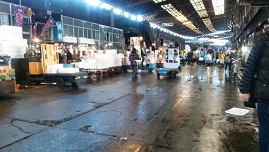 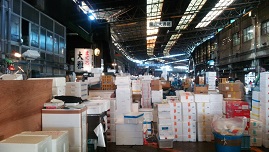
This is the scenery of Tsukiji Market Morning at the end of the year.
There is also a tarley that moves around with tantantin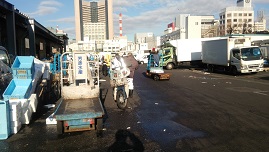
Carriages that are rushing ahead with progress
There is also a scream that can be heard from the shadow of the cargo
"Shiomachi Chaya" waits for a leisurely shipment.
The rush of the owner of the restaurant that carries the purchased fish
I can't see the end of next year.
Tsukiji Market will be fully relocated to Toyosu, Koto-ku in November next year.
Please take a look at the last scenery of the end of the year.
“Tsukiji Central Wholesale Market” was relocated from Nihonbashi in 1935 in 2016.
It begins with a history of 80 years.
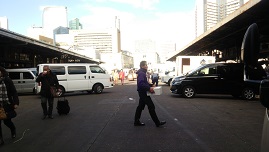
[Nojinya]
December 31, 2015 09:00
As announced in the blog post on December 3 (/archive/2015/12/post-2910.html), construction work for major renovations in the Heisei era (rebuilding of shrine office, etc.) has been underway since November. The grounds were surrounded by a white board with dumps and construction equipment, so I was worried that new year worshipping would not be able to go as it was, but last week, temporary construction was suspended and visitors could enter and exit from the main gate Was. 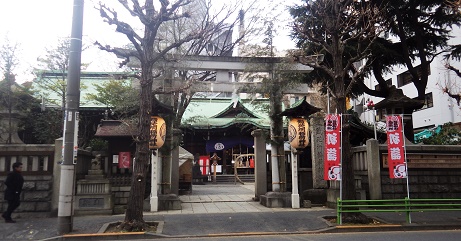 In front of main hall, Chinowa for New Year's Eve exorcism has already been prepared, and the part where shrine office was located remains surrounded by a white board, but as usual, this New Year seems to be safe. In front of main hall, Chinowa for New Year's Eve exorcism has already been prepared, and the part where shrine office was located remains surrounded by a white board, but as usual, this New Year seems to be safe.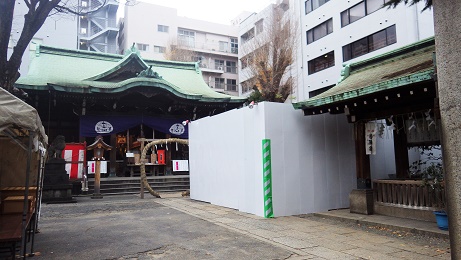
I would like to inform you as soon as possible because I thought it was a concern to our blog readers.
Added: The Kannaka Misogi (Kannaka Bathing Tournament) on January 10 (Sun) seems to be held at Tepposu Park from 11:00 am. 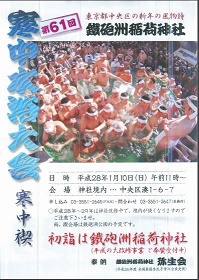 [Tepposhu Inari Shrine] [Tepposhu Inari Shrine]
Location 1-6-7 Minato, Chuo-ku, 104-0043, Japan
Phone: 03-3551-2647
Access Get off at the Tokyo bus "Higashi 15" and Edo bus "South circulation" gunshot stop. Chuo-ku community cycle "B01 gunshot children's park" cycle port soba.
[Yotaro]
December 30, 2015 17:00
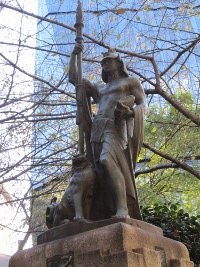 Despite being in a prominent place called Sukiyabashi Park, the copper engraving commemorating the reconstruction of the earthquake, "Lighthouse" by Seibo Kitamura (1884-1987) is not attracting much attention. This memorial tower, which is right next to the long line seeking a jumbo lottery, is unlikely to be noticeable. This sculpture was 45 years old Nishibo, a professor at Tokyo Bijutsu School at the time, and exhibited at the 12th Tei Exhibition in 1931 (1931) in 1933 (1933), the tenth year of the Great Kanto Earthquake through a community donation. It was installed as an earthquake monument on September 1st. Despite being in a prominent place called Sukiyabashi Park, the copper engraving commemorating the reconstruction of the earthquake, "Lighthouse" by Seibo Kitamura (1884-1987) is not attracting much attention. This memorial tower, which is right next to the long line seeking a jumbo lottery, is unlikely to be noticeable. This sculpture was 45 years old Nishibo, a professor at Tokyo Bijutsu School at the time, and exhibited at the 12th Tei Exhibition in 1931 (1931) in 1933 (1933), the tenth year of the Great Kanto Earthquake through a community donation. It was installed as an earthquake monument on September 1st.
There is a lion, a king of beasts, at the feet of a young man wearing a helmet holding a torch. Is it a powerful male image that Nishibo is good at symbolizing the city of Tokyo, which is revived robustly? The design of the pedestal is also Nishibo, with a self-written nameplate of the slogan "Preparing for unexpected earthquakes" that was solicited for sweepstakes.
It is said that "natural disasters come when you forget them", but recently it may be better to say, "I will come soon after you forget." When I go to Yurakucho, I often stop by this statue and keep in mind that I will be prepared for my daily routine. I hope the new year will be a calm year without disaster.
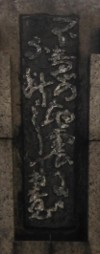 [Adding] [Adding]
Seibo Kitamura is from Nagasaki Prefecture, a person who studied with the goal of two geniuses, Fumio Asakura and Taimu Tatehata, and worked hard to embody his favorite words, "Tamazaru Walking Soroshi Cochlea." In Tokyo, you can see many works of Saibo at the sculpture garden in the Inokashira Natural Culture Park. In 1958 (1958), Fumio Asakura was the second medal of culture, followed by Fumio Asakura, and in 1980 (1980), honorary citizen of Tokyo and honorary citizen of Nagasaki Prefecture. In 1987 (1987), he died long at the age of 102. The late masterpiece "Nagasaki Peace Prayer Statue" was completed in 1955 in five years with many difficulties, slander, and obstruction, and now prays for the happiness of war victims and world peace. .
`One more thing,'
The winner of the sumo wrestling Tokyo main place will be awarded the Tokyo Governor's Award, but the prize is a statue of "Lion Guijin" by Seibo Kitamura. The first prize winner in May 1981 (1981) was the lake of Toyoko Tsunakita at the time, the president of the Sumo Association, who died suddenly the other day.
[Nojinya]
December 30, 2015 14:00
During this time, Western Europe is a beautiful season with decorations to celebrate Christmas and New Year. I think that there are many people who usually visit Paris at the end of the year, but this year I am a little worried about terrorism. This is a story about searching for France in Chuo-ku. In Chuo-ku, there are few shops and facilities related to France, including Plantan Ginza, but today, one of them is MMM (Maison des Musées du Monde (Maison de Musées du Monde) in Ginza. I visited.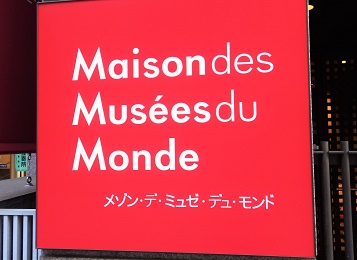
This is a cultural facility that DNP (Dainippon Printing) has been conducting as a cultural activity since 2003, providing information on museums (art galleries and museums) and displaying and selling official museum goods. Since 2013, we have been expanding our activities not only in France but also in Europe and the world, based on the concept of "living art and design around the world."
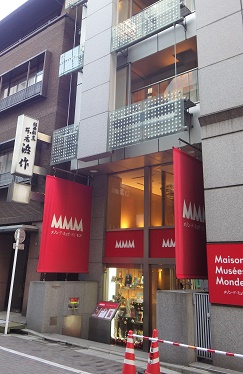
The location is near Suzuran Street on the west side of Chuo-dori and Kojunsha Street. Nearby is Kojunsha, which was established in 1880 by Keio founder Yukichi Fukuzawa as Japan's oldest social club, and has many restaurants. "Hamasaku" from Kansai Kappo cuisine, introduced by correspondent CAM in the Snow Series (7) (/archive/2015/12/post-2972.html) on December 26, is also next to it.
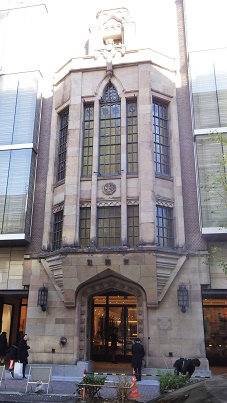 [Kojun Building] ⇒The facade of Kojunsha remains as part of the building. [Kojun Building] ⇒The facade of Kojunsha remains as part of the building.
At the entrance of the glass-walled building, Akachi has a stylish design with a signature of the three letters of MMM. 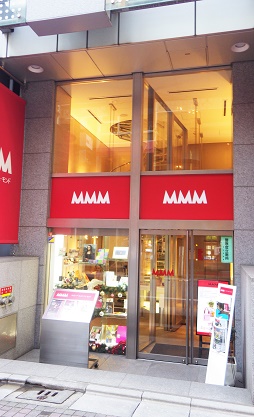 I'll go inside. The first and second floors are museum shops, providing information on museums in Europe, mainly in Louvre and France, as well as exhibiting and selling museum goods. It's not a very large space, but there are French museums such as Louvre (Paris), Orsée (Paris), Versailles (Paris), Luxembourg Museum (Paris), Carvee Museum (Avignon), as well as the Clai Centre (Bern), the British Museum (London), the Tate Gallery (London), and the Vienna Museum of Fine Arts and Museum of Fine Arts in Vienna in the European Centre (Venna. I'll go inside. The first and second floors are museum shops, providing information on museums in Europe, mainly in Louvre and France, as well as exhibiting and selling museum goods. It's not a very large space, but there are French museums such as Louvre (Paris), Orsée (Paris), Versailles (Paris), Luxembourg Museum (Paris), Carvee Museum (Avignon), as well as the Clai Centre (Bern), the British Museum (London), the Tate Gallery (London), and the Vienna Museum of Fine Arts and Museum of Fine Arts in Vienna in the European Centre (Venna.
When you climb up to the third floor by elevator, you will be separated from the museum because of the art space, and there will be a special exhibition on the theme of graphic art and design. We were just holding the "Christmas Table Goods Special" (until December 25). I couldn't take photos, so I'm sorry that I couldn't tell the blog readers about it, but it was a relaxing exhibition that reflected the seasonal atmosphere.
Next, I will go to the MMM library on the first basement floor.
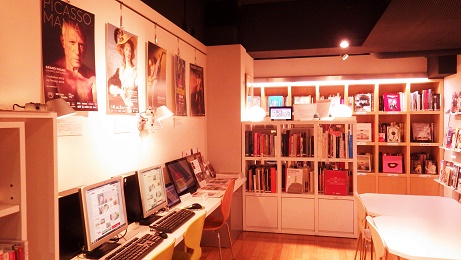
[MMM Library (1st basement floor)] ⇒This shooting has been approved by MMM.
While other spaces are exhibited and sold, this is a space where you can view exhibition catalogs of museums around the world and art-related materials stored by MMM. It seems to be useful to look at local art information before actually going to Paris or Europe, such as slowly looking at materials at the table or browsing multimedia software using a personal computer.
There is Ginza Graphic Gallery (ggg) along the adjacent Kojunsha Street, but it is currently closed for renovation and is scheduled to open on April 15. 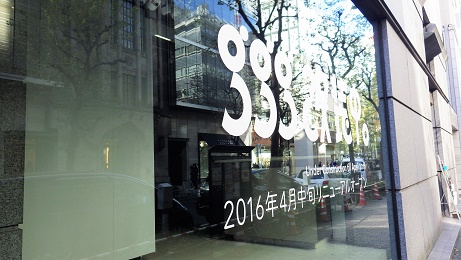 This is not limited to Europe such as France, but it is a place to disseminate graphic design, but it seems that activities in cooperation with MMM will also be carried out when reopening. This is not limited to Europe such as France, but it is a place to disseminate graphic design, but it seems that activities in cooperation with MMM will also be carried out when reopening.
【MMM(Maison des Musées du Monde)】
Location 7-7-4 Ginza, Chuo-ku, 104-0061, Japan (DNP Ginza Annex)
Phone: 03-3574-2380
Business hours From 11:00 to 19:00 (Sunday holiday)
Admission fee: Free of charge
[Nojinya]
December 29, 2015 16:00
Sunday, November 1st. The whole museum 2015 will be held in Chuo-ku, and 26 correspondents of the Chuo-ku Tourism Association, including the second "Chufuchu-Ii", will board a free patrol bus. And served as a guide for the city with a microphone in one hand. On the day of the event, there were various incidents such as adjustment of the number of passengers and time adjustment of the operation interval, and heavy traffic congestion due to a demonstration march in the Ginza area, but the task of "telling customers the charm of Chuo-ku" is a great opportunity for our correspondent to show the results of our usual study.
While on a free patrol bus clockwise, depart from the bus platform in Higashinihombashi to head to the Hamacho bus platform and turn left. One of the customers said, "Is it the name of a woman by passing Miyuki?" A simple question is asked. 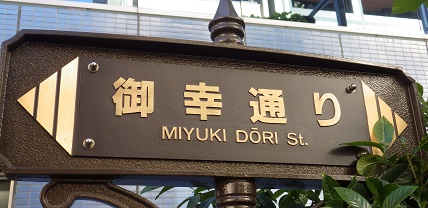 On the road name information board outside the window, "Miyuki-dori (MIYUKI DORI)" is written, and I often hear the name "Miyuki" (although there are characters such as Miyuki and Miyuki) in the female name, popular manga There was also a protagonist! On the road name information board outside the window, "Miyuki-dori (MIYUKI DORI)" is written, and I often hear the name "Miyuki" (although there are characters such as Miyuki and Miyuki) in the female name, popular manga There was also a protagonist!
If you examine the kanji character "Miyuki" in a dictionary, it reads "Miyuki, Goko, Gyoko" and says it has the same meaning as "Yukiyuki" in The Tale of Genji and history textbooks. If so, is this "Miyuki-dori" also the street where His Majesty the Emperor passed? However, if it is Gyoko-dori, which connects the Imperial Palace Square in Marunouchi to the front of Tokyo Station, it will be a street when you take a train from Tokyo Station. I guess, but when it comes to Higashinihombashi, it will be "a little far from the Imperial Palace, but why?"
The reason was at the Rinko Monument next to the bus stop in Higashinihombashi. Before the war, the location where Nihonbashi Junior High School is currently built was Chiyoda Hirone Elementary School (founded in 1877, closed in 1945).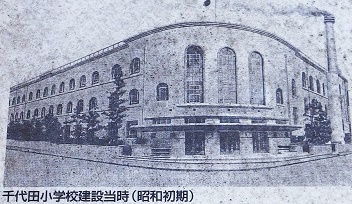
[Chiyoda Hirone Elementary School in the early Showa era (from the Chuo-ku Board of Education explained version)]
In 1923, Tokyo was hit by the Great Kanto Earthquake, and many areas, including Chiyoda Hirone Elementary School, became burnt fields. Chiyoda Hirone Elementary School was completed in December 1929 with a non-combustible structure of reinforced concrete as a reconstruction elementary school through the earthquake disaster recovery project, but visited the Imperial capital where His Majesty the Emperor revived in March 1930 the following year At the time, it seems that the car was stopped near the school and the monument was stopped at the school for a break and the name of the memorial.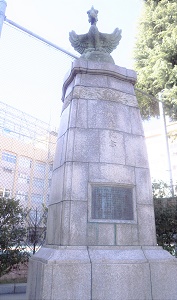
[Rinyuki Monument]
By the way, speaking of "MIYUKI DORI" in Chuo-ku, there is another famous "Miyuki-dori" in Ginza. While MIYUKI DORI of Higashinihombashi is kanji, it is written in hiragana, but this street that connects Shimbashi Enbujo and Hibiya Park and runs through Ginza 5-6 chome in parallel with Harumi-dori St. It was famous as a sacred place for the Miyuki tribe. Shortly before the start of the Tokyo Olympics in 1964, a social phenomenon in which young people with unique fashion that slightly broke the eyebrows hang out and walked around Miyuki Street was called the "Miyuki tribe". Today, as you can see, it is gaining popularity as a gorgeous street lined with brand shops. 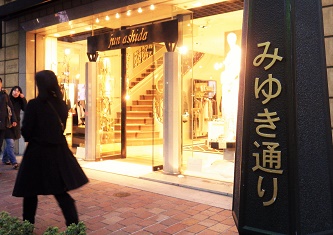 Of course, "Miyuki-dori" in Ginza also comes from "Yuki (= Miyuki)", and this is the road that was passed when Emperor Meiji went to Naval Academy, Naval University, Hamarikyu, etc. in Tsukiji. Of course, "Miyuki-dori" in Ginza also comes from "Yuki (= Miyuki)", and this is the road that was passed when Emperor Meiji went to Naval Academy, Naval University, Hamarikyu, etc. in Tsukiji.
[Miyuki Street]
Location From 2-2 Higashi Nihonbashi, Chuo-ku to 2-10 Higashi Nihonbashi.
[Rinyuki Monument]
Location 1-10-1, Higashi-Nihonbashi, Chuo-ku, 103-0004, Japan (Nihonbashi Junior High School Hamacho Riverside Street)
[Miyuki Street]
Location From 5-1 Ginza, Chuo-ku to 6-4 Ginza.
[Nojinya]
December 29, 2015 09:00
More than a week  before before  the 92nd Hakone Ekiden Main Event of New Year's Day. There is a sign saying "Notice of Traffic Regulation" on Kajibashi Street, which tells you that this will be the Hakone Ekiden course on January 3 of the New Year. the 92nd Hakone Ekiden Main Event of New Year's Day. There is a sign saying "Notice of Traffic Regulation" on Kajibashi Street, which tells you that this will be the Hakone Ekiden course on January 3 of the New Year.  On the outbound route, start in front of the Yomiuri Shimbun headquarters in Otemachi, go straight south on Hibiya Street in Chiyoda-ku, but the last 10th ward on January 3 runs in Chuo-ku. In this way, Hakone Ekiden is a big event of the New Year, but in addition to running in Chuo-ku in the last ward, this race, in fact, has a deep connection with Chuo-ku. On the outbound route, start in front of the Yomiuri Shimbun headquarters in Otemachi, go straight south on Hibiya Street in Chiyoda-ku, but the last 10th ward on January 3 runs in Chuo-ku. In this way, Hakone Ekiden is a big event of the New Year, but in addition to running in Chuo-ku in the last ward, this race, in fact, has a deep connection with Chuo-ku.
Currently, the start / goal point is Otemachi, where the Yomiuri Shimbun headquarters is located, but from the postwar period until 1971, the headquarters of the Yomiuri Shimbun was in Ginza (currently the place   where Plantan Ginza is located), Ginza in Chuo-ku was exactly the start / goal of Hakone Ekiden. where Plantan Ginza is located), Ginza in Chuo-ku was exactly the start / goal of Hakone Ekiden.
Unfortunately, among the 21 teams participating this year, there is no university in Chuo-ku, but three of them are universities closely related to Chuo-ku in history.
One is Juntendo University. This university currently has campuses in Hongo and Sakura (Chiba Prefecture), but in 1838 (Tenpo 9), Taizen Sato founded Wada Juku in Yagenbori (currently Higashinihombashi) where he studied Dutch medicine. It is the origin.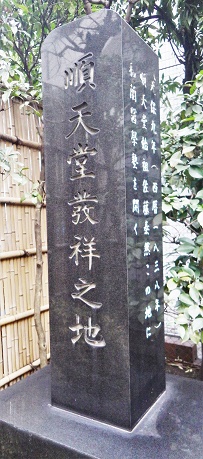
[The Monument of the birthplace of Juntendo in Yagenbori]
The second school is Chuo Gakuin. This is currently headquartered in Abiko City (Chiba Prefecture), but its origin is Nihonbashi Simple Commercial Night School, which was established in Shinkawa in 1900. After that, Nihonbashi Simple Commercial Night School became a Central Commercial School and Chuo Commerce Junior College, and junior colleges were abolished in 2000, but it is Chuo Gakuin University that participated this time.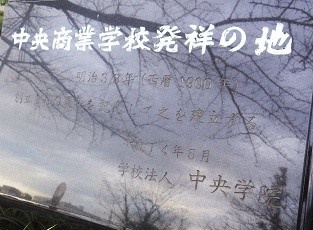
[Monument of the birthplace of Chuo Commercial School (Chuo Gakuin) in Shinkawa Park]
The third school is Aoyama Gakuin, who won last year. The current headquarters is also located in Shibuya, but its origins are Kogaku Gakusha, which was established in 1878 by Julius Sober in Tsukiji Akashicho. Kokyo Gakusha later merged with Azabu Women's Elementary School (later relocated to Akashicho to become a coastal girls' school) and Mikai Shin School in Yokohama Yamate, and became Aoyama Gakuin after going through Tokyo English School and Tokyo Eiwa School. 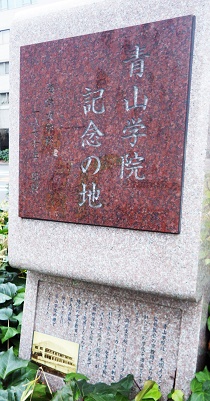 [Aoyama Gakuin Memorial Land in Akashicho] Monument [Aoyama Gakuin Memorial Land in Akashicho] Monument
The anchor runners who climbed Hibiya-dori, the 10th ward of the return trip on January 3, turn right at Baba Sanmon who climbed Hibiya-dori, the 10th ward of the return trip on January 3, turn right at Baba Sanmon  (Marunouchi, Chiyoda-ku) and enter Kajibashi-dori. After crossing (Marunouchi, Chiyoda-ku) and enter Kajibashi-dori. After crossing  the Shinkansen guard and Sotobori-dori St. and entering Chuo-ku, turn left in the Shinkansen guard and Sotobori-dori St. and entering Chuo-ku, turn left in  front of Tokyo Square Garden, enter Chuo-dori, cross Nihonbashi and front of Tokyo Square Garden, enter Chuo-dori, cross Nihonbashi and run through the ward at once to Tokiwa Bridge. Actually, this course was a different course until 17 years ago. In 1999, the course was changed to Kyobashi and Nihonbashi to commemorate the 88th anniversary of the Nihonbashi Bridge and the 75th Hakone Ekiden Convention. Along this line is the Meiji Seimeikan (Marunouchi, Chiyoda-ku), Mitsubishi Ichigokan Museum, Tokyo (Marunouchi), Dai-ichi Seimei Mutual Hall (Kyobashi), Meijiya (Kyobashi), Takashimaya (Nihonbashi), Mitsukoshi (Nihonbashi Muromachi), and the Bank of Japan (Honishimachi) are expected to have many traditional and beautiful buildings. It's a good course to enjoy the cityscape with support! run through the ward at once to Tokiwa Bridge. Actually, this course was a different course until 17 years ago. In 1999, the course was changed to Kyobashi and Nihonbashi to commemorate the 88th anniversary of the Nihonbashi Bridge and the 75th Hakone Ekiden Convention. Along this line is the Meiji Seimeikan (Marunouchi, Chiyoda-ku), Mitsubishi Ichigokan Museum, Tokyo (Marunouchi), Dai-ichi Seimei Mutual Hall (Kyobashi), Meijiya (Kyobashi), Takashimaya (Nihonbashi), Mitsukoshi (Nihonbashi Muromachi), and the Bank of Japan (Honishimachi) are expected to have many traditional and beautiful buildings. It's a good course to enjoy the cityscape with support!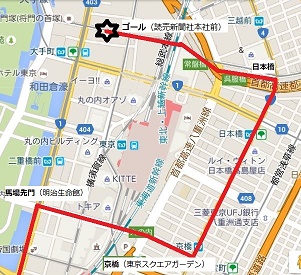
Last year's Hakone Ekiden has been reported in detail by correspondent Tataro Edo with photos (/archive/2015/01/post-2270.html).
Monument of the birthplace of Juntendo
Location 2-6-8, Higashi Nihonbashi, Chuo-ku, 103-0004, Japan (Yagenbori Fudoin precinct)
[Monument of the birthplace of the Central Commercial School]
Location 1-32, Shinkawa, Chuo-ku, 104-0033, Japan (in Shinkawa Park)
[Monument of Aoyama Gakuin Memorial Land]
Location 6-26 Akashicho, Chuo-ku, 104-0044, Japan (in front of Nichirei Akashicho Building)
|
Links
|




 In front of main hall, Chinowa for New Year's Eve exorcism has already been prepared, and the
In front of main hall, Chinowa for New Year's Eve exorcism has already been prepared, and the 




 I'll go inside. The first and second floors are museum shops, providing information on museums in Europe, mainly in Louvre and France, as well as exhibiting and selling museum goods. It's not a very large space, but there are
I'll go inside. The first and second floors are museum shops, providing information on museums in Europe, mainly in Louvre and France, as well as exhibiting and selling museum goods. It's not a very large space, but there are 
 This is not limited to Europe such as France, but it is a place to disseminate graphic design, but it seems that activities in cooperation with MMM will also be carried out when reopening.
This is not limited to Europe such as France, but it is a place to disseminate graphic design, but it seems that activities in cooperation with MMM will also be carried out when reopening. On the road name information board outside the window, "Miyuki-dori (MIYUKI DORI)" is written, and
On the road name information board outside the window, "Miyuki-dori (MIYUKI DORI)" is written, and


 On the outbound route, start in front of the Yomiuri Shimbun headquarters in Otemachi, go straight south on Hibiya Street in Chiyoda-ku, but the last 10th ward on January 3 runs in Chuo-ku.
On the outbound route, start in front of the Yomiuri Shimbun headquarters in Otemachi, go straight south on Hibiya Street in Chiyoda-ku, but the last 10th ward on January 3 runs in Chuo-ku.




